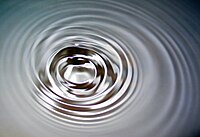
Photo from wikipedia
Surface treatment intensity monitoring is still an open and challenging nondestructive testing problem. For the estimation of residual stress with ultrasonic measurements, local linear and nonlinear elastic constants are needed… Click to show full abstract
Surface treatment intensity monitoring is still an open and challenging nondestructive testing problem. For the estimation of residual stress with ultrasonic measurements, local linear and nonlinear elastic constants are needed as input. In this paper, nonlinear elastic-wave interactions (also called wave mixing or scattering) - namely, the generation of secondary ultrasonic waves in a nonlinear medium - are considered as a prospective means for near-surface nonlinear elastic parameter evaluation. The allowed interactions between bulk and surface waves, as well as the dependence of the scattering efficiency on the frequency and angle between source waves, were investigated through an analytical model, then compared with FEM simulations and experimental results. Finally, possible future steps for the development of the applied methods for the determination of near-surface higher-order elastic constants are discussed. In addition, several problem-relevant data processing procedures are presented.
Journal Title: Ultrasonics
Year Published: 2022
Link to full text (if available)
Share on Social Media: Sign Up to like & get
recommendations!